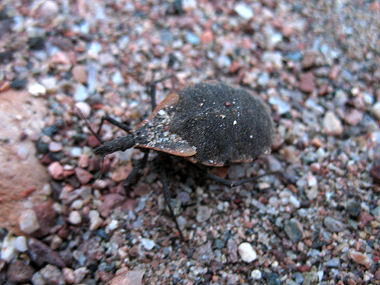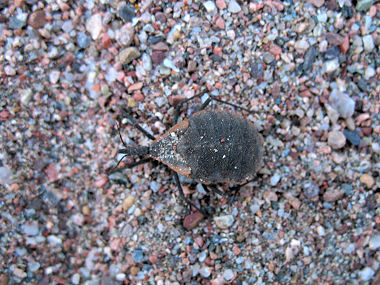The Western Conenose Bug (also called a Kissing Bug) is a member
of the Reduviidae Family, which also includes assassin bugs. The nocternal
insect is 3/4-inches long with a brown-black, flat, narrow body and wings (in
the adult form) which form a distinctive "X" when folded over the abdomen .
The young resemble their parents except that they are smaller and have no
wings. Kissing bugs get their name from the fact that they sometimes feed on
people by painlessly piercing the lips, eyelids or ears of a sleeping human
victim. During feeding, the bug injects its numbing saliva, which can sometimes
result in anaphylactic shock to persons sensitive to the bite. In rare cases
the bugs can also pass along Chagas disease, a form of African sleeping
sickness, however, it is not believed that insects in the southwest carry this
disease. .
The young resemble their parents except that they are smaller and have no
wings. Kissing bugs get their name from the fact that they sometimes feed on
people by painlessly piercing the lips, eyelids or ears of a sleeping human
victim. During feeding, the bug injects its numbing saliva, which can sometimes
result in anaphylactic shock to persons sensitive to the bite. In rare cases
the bugs can also pass along Chagas disease, a form of African sleeping
sickness, however, it is not believed that insects in the southwest carry this
disease.
|
The photos on this page are of the nymph
form of a Western Conenose Bug. It's fat because it bit me. |
Adult kissing bugs are most often encountered in summer and
fall, and are attracted to lights. They typically remain hidden during the day,
often living in the dens of wood rats. The Western Conenose bug reproduces once
per year.
 |

